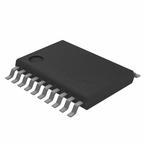The bq76925 host-controlled analog front end (AFE) is part of a complete pack monitoring, balancing, and protection system for 3-, 4-, 5-, or 6-series cell Li-Ion and Li-Polymer batteries. The bq76925 device allows a Host controller to monitor individual cell voltages, pack current and temperature easily. The Host may use this information to determine unsafe or faulty operating conditions such as overvoltage, under- voltage, overtemperature, overcurrent, cell imbalance, state of charge, and state of health conditions.
●Cell input voltages are level-shifted, multiplexed, scaled, and output for measurement by a Host ADC. A dedicated pin provides a low-drift calibrated reference voltage to enable accurate measurements.
●The voltage across an external-sense resistor is amplified and output to a Host ADC for both charge and discharge current measurements. Two gain settings enable operation with a variety of sense resistor values over a wide range of pack currents.
●To enable temperature measurements by the Host, the AFE provides a separate output pin for biasing an external thermistor network. This output can be switched on and off under Host control to minimize power consumption.
●The bq76925 device includes a comparator with a dynamically selectable threshold for monitoring current. The comparator result is driven through an open-drain output to alert the host when the threshold is exceeded. This feature can be used to wake up the Host on connection of the load, or to alert the Host to a potential fault condition.
●The bq76925 device integrates cell balancing FETs that are fully controlled by the Host. The balancing current is set by external resistors up to a maximum value of 50 mA. These same FETs may be utilized in conjunction with cell voltage measurements to detect an open wire on a cell sense-line.
●The Host communicates with the AFE through an I2C interface. A packet CRC may optionally be used to ensure robust operation. The device may be put into a low-current sleep mode through the I2C interface and awakened by pulling up the ALERT pin.


